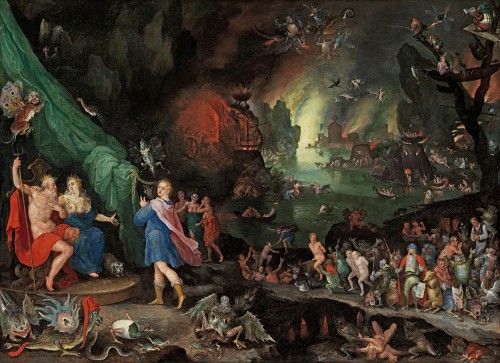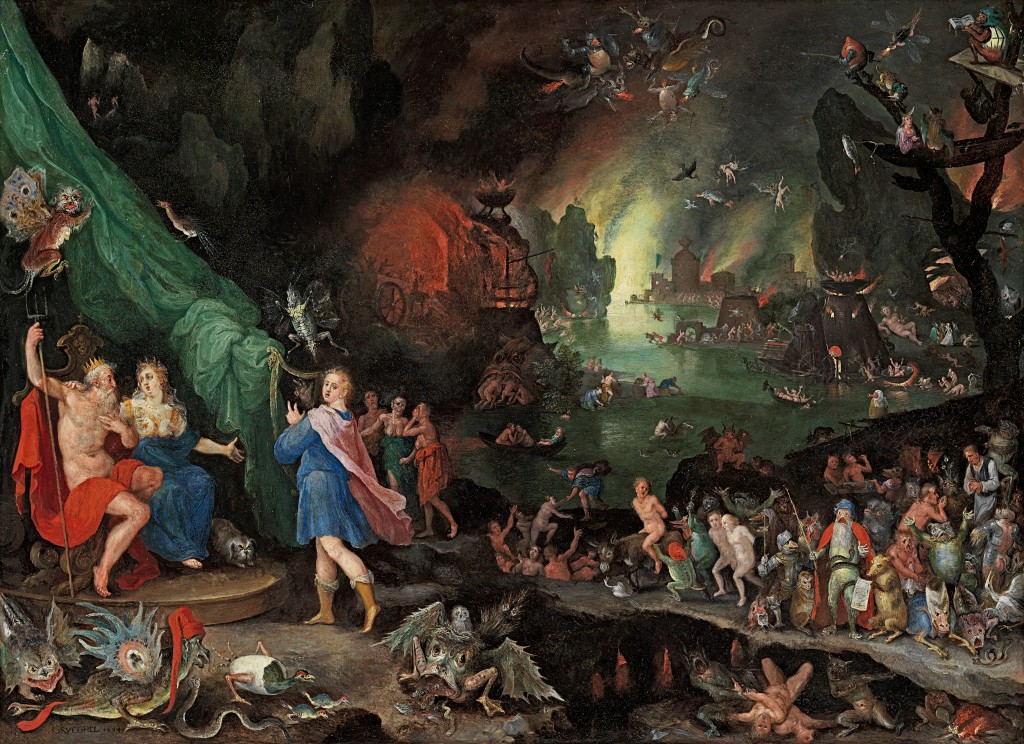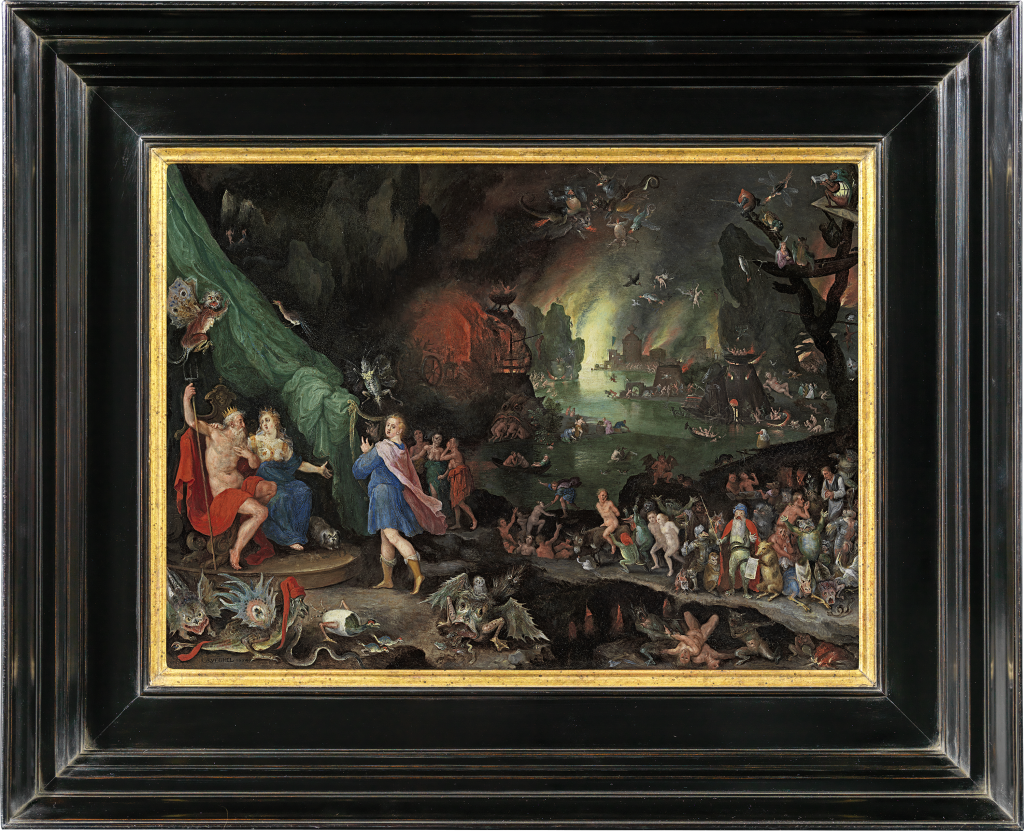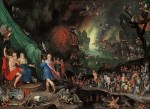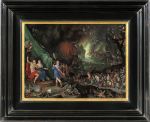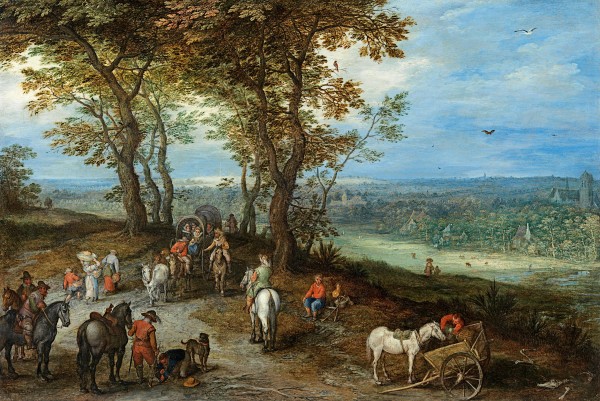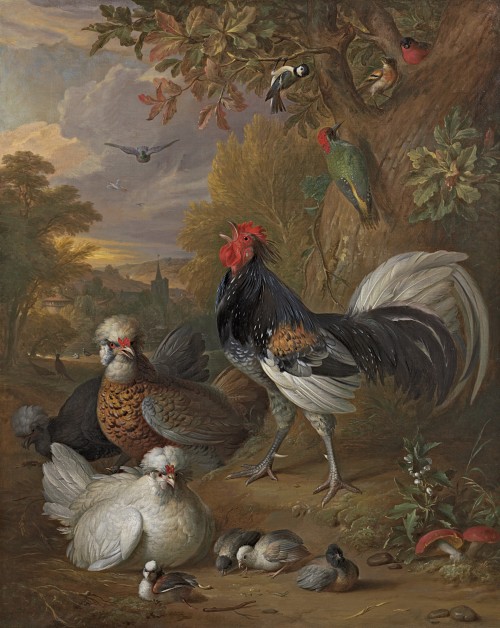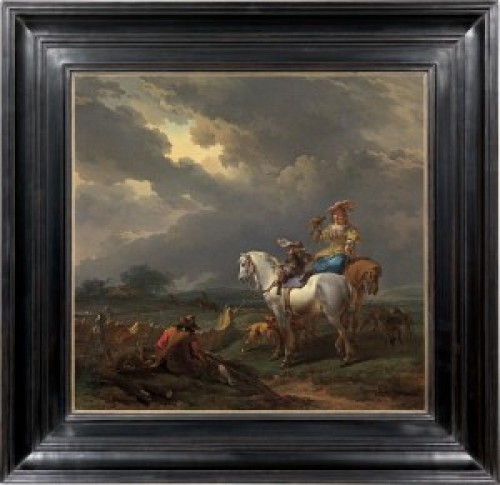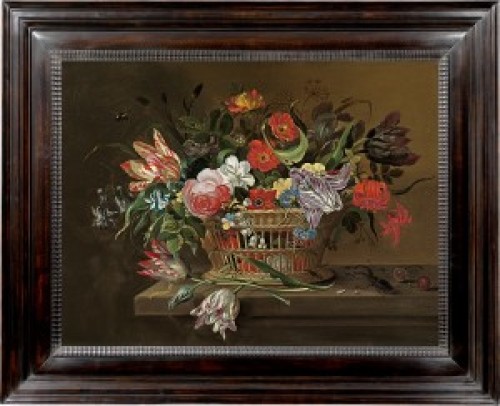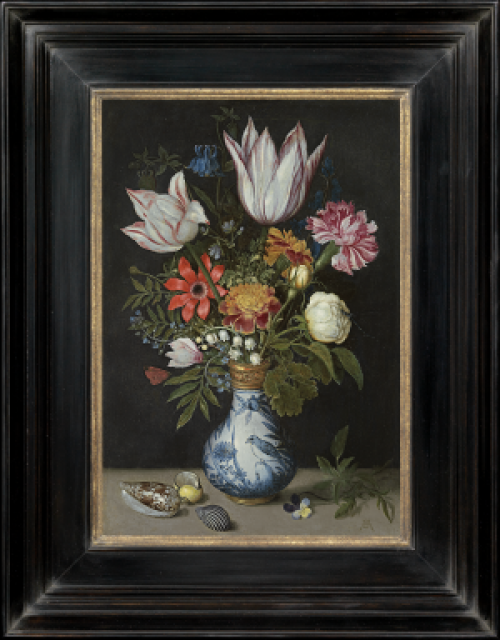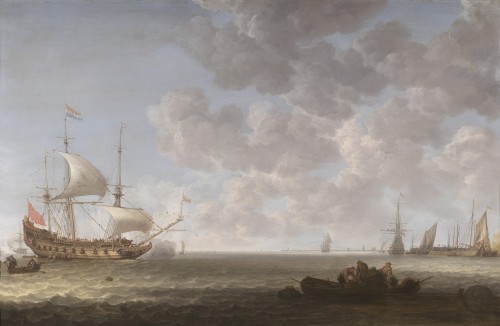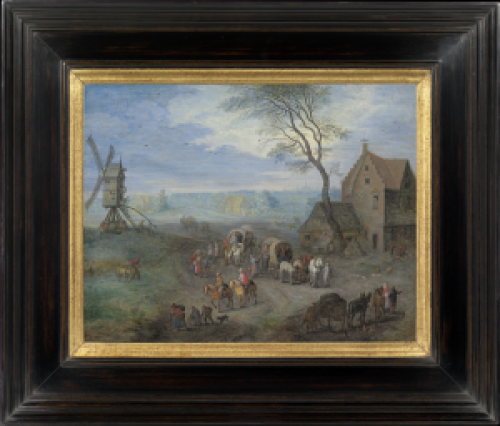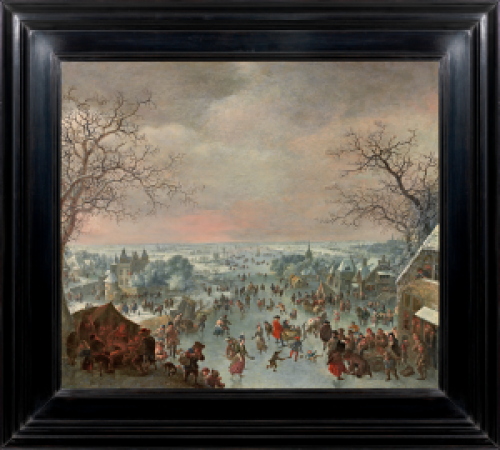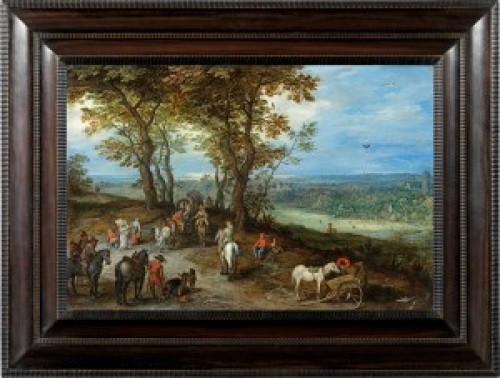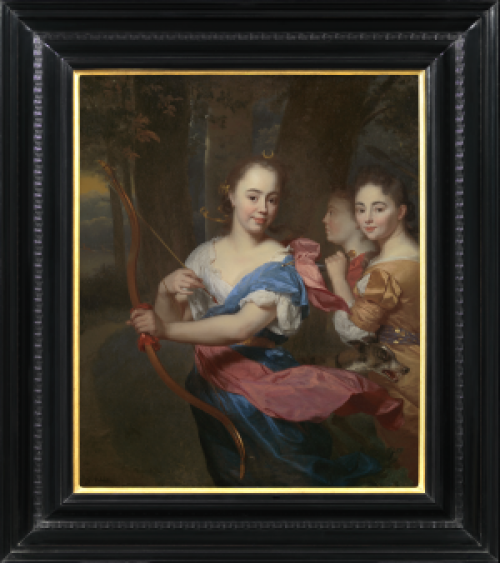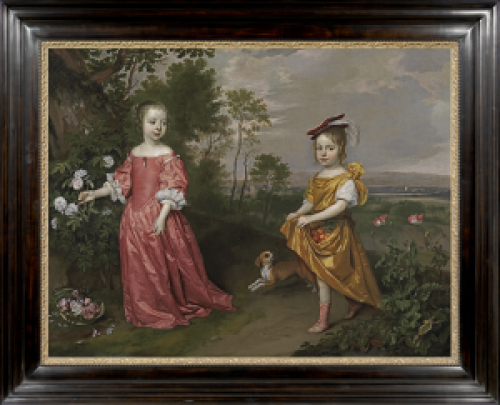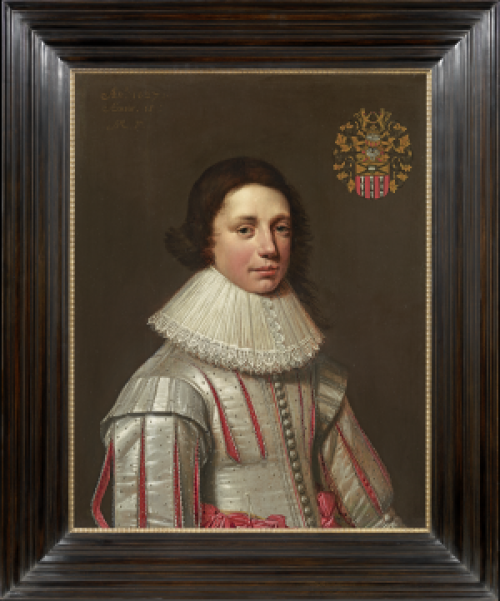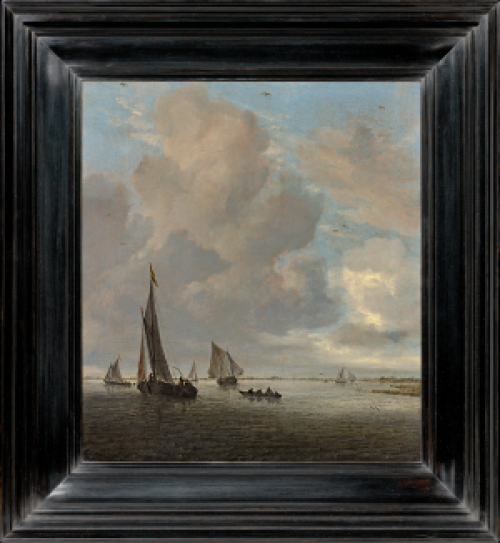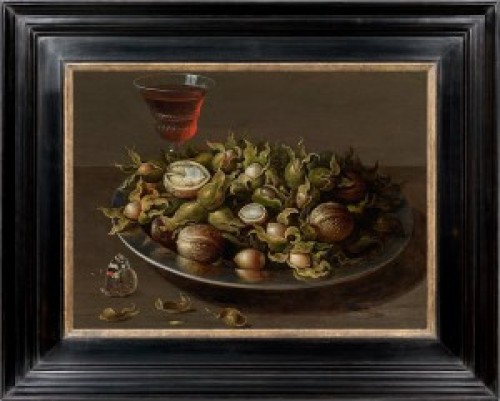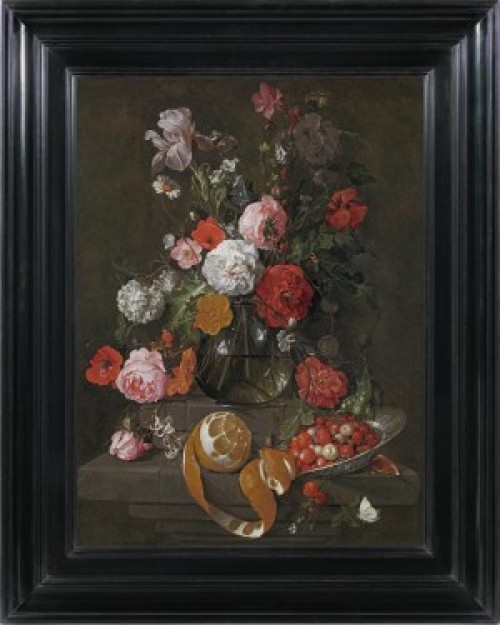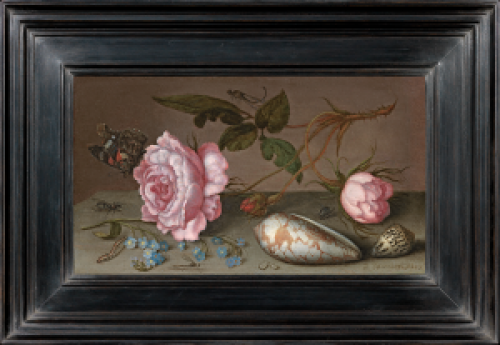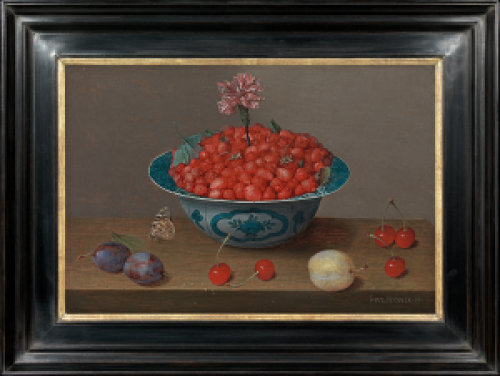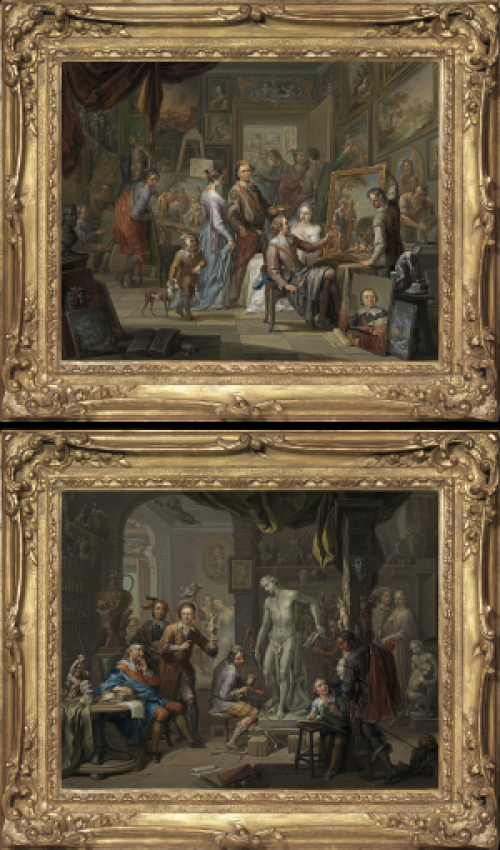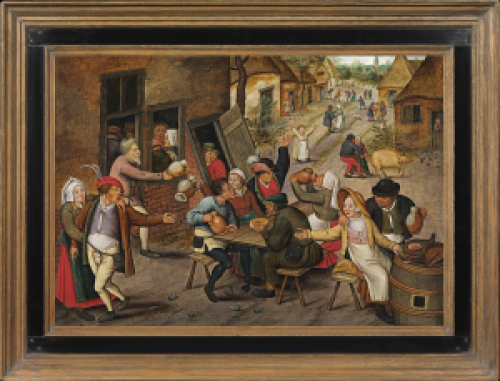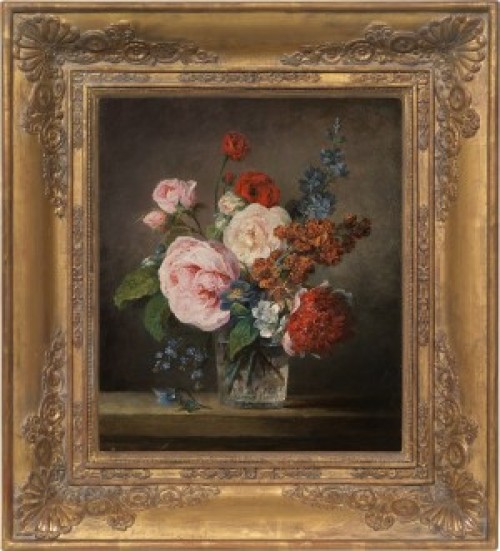JAN BRUEGHEL THE ELDER
1568 - Antwerp - 1625
Ref: BZ 164
Orpheus playing to Pluto and Proserpine
Signed and dated lower left: BRVEGHEL 1594
Oil on copper: 10 1/8 x 13 7/8 in / 25.7 x 35.2 cm
Frame size: 16 ¼ x 20 in / 41.3 x 50.8 cm
In a black polished Dutch seventeenth century style frame
Provenance:
Paul Weibel, Strasbourg, France;
from whom acquired in 1978 by a private collector, France;
by descent
Klaus Ertz has confirmed that this is an autograph work by Jan Brueghel the Elder
Jan Brueghel the Elder was the younger son of Pieter Bruegel the Elder (1525-1569), one of the most influential artists of the sixteenth century. Famed throughout Europe, avidly collected by Kings and Emperors, Pieter Bruegel’s work fused landscape and history painting with realism and psychological insight. Jan was only one year old when his father died, but he had the benefit of the flourishing Breugel studio and was trained by his grandmother, the miniature painter Mayken Verhulst Bessemers.
In 1589 Jan Brueghel set off for Italy, the crucial ‘finishing school’ for élite northern European artists in his day. This extraordinary painting of Orpheus playing to Pluto and Proserpine was executed in 1594, when Jan was living in Rome, surrounded by Classical treasures and amid the intellectual ferment of the Renaissance. Among his patrons were Cardinal Ascanio Colonna (1560-1608) and Cardinal Federico Borromeo (1564-1631), learned men from leading aristocratic families.
Brueghel’s exquisite Orpheus playing to Pluto and Proserpine would have delighted prominent Churchmen and intellectuals alike, all of them deeply read in Classical as well as Christian literature. The painting depicts an episode from Book X of the Metamorphoses of the Roman poet Ovid (43 BC-c.17 AD). Orpheus, son of the nymph Calliope, muse of eloquence and poetry, and Oeagrus, King of Thrace, descended into the Underworld in search of his wife Eurydice, who had been killed by a snake. Brueghel depicts the moment when Orpheus plays the lyre and sings to charm the King and Queen of the Underworld, Pluto and Proserpine. They are deeply moved, as are the Furies standing behind them: normally pitiless hags moved to tears. The torments of the Underworld are temporarily suspended by the power of art.
Pluto grants Orpheus’s wish. He will be allowed to lead Eurydice back to the world of the living, provided that he does not look at her until they reach the sunlight. Unaware of this bargain, Eurydice is anguished by her husband’s seeming coldness and, unable to bear her piteous cries any longer, Orpheus turns to look at her. She vanishes back into the Underworld for ever.
Brueghel combines ideas of the Classical Underworld with the Christian Hell in this painting. He creates an array of Underworld creatures of fantastic inventiveness and brilliant miniaturist technique, drawing on his training with Mayken Verhulst and the inspiration of his Rome-based fellow Fleming Paul Bril (1554-1626), who painted delicate, small-scale landscapes on copper. In Orpheus, figures in the background, only a few millimetres high, read as vividly as those in the foreground. The setting, with its crazily destabilizing mountains and plunging ravines, falling bodies and roaring fires, strikes terror into the viewer.
The surreal, grimly comic demons, composites of many animals and plants, are part of the Northern tradition, seen for example in the paintings of Hieronymus Bosch (c.1450-1516). There is an element of contemporary satire in the lady in fashionable dress on the right margin of the painting, escorted by demons, and the boar calmly reading a newssheet – surely promulgating ‘fake news’ - in the right foreground.
The figures of Pluto, Proserpine and the naked sinners reflect Brueghel’s study of classical Roman sculpture in an era when more and more was being unearthed as a result of Renaissance infatuation with the city’s glorious past. The writhing man being dragged into the abyss by a devil in the right foreground echoes the energy found in Hellenistic sculpture such as the Laocoön group (c.40-30 BC), which was excavated in 1506 and acquired by Pope Julius II for the Vatican collections. Brueghel also drew on his knowledge of Michelangelo’s Sistine ceiling and Luca Signorelli’s Last Judgement in Orvieto Cathedral. With their sense of movement and acutely-observed anatomy, the nudes in his Orpheus have a monumentality far beyond their actual size. The brilliant hues employed in the main figure groups reflect Jan’s encounter with Venetian painting and also a very Flemish enjoyment of rich colour: Flanders had a flourishing textile industry. Brueghel revels in Pluto’s swathe of scarlet cloak, Proserpine’s lapis blue dress and the blue tunic and pink cloak worn by Orpheus, all contrasted by a mint green curtain, helpfully held up by demons.
Orpheus is a cabinet painting, meant to be held in the hands and minutely observed. Its technical brilliance and the literary and philosophical ideas that it sparked would have been discussed among a sophisticated circle of friends, no doubt after a dinner of the finest food and wine. The smooth copper support, more expensive than the more common wood panel, shows off Jan Brueghel’s almost miraculous dexterity and dynamism. This is the painting of a twenty-six-year-old artist setting off to charm and conquer the world: truly a second Orpheus who kept Kings and Cardinals in thrall.
Jan Brueghel made three more paintings of this subject, all on copper and of roughly the same size as the present work, but all with variations in the figure groups and details of the composition. The fact that all four works are on copper and two are part of royal and aristocratic collections reflects the prestige of the Orpheus group, which was aimed at the richest and most discerning of connoisseurs. One version is in the Galleria Palatina in the Palazzo Pitti, Florence (inv. no.1298)[1], which houses the collection of the Medici rulers of that city. It probably originally belonged to the diplomat Cardinal Francesco Maria Bourbon del Monte Santa Maria (1549-1627), an important patron of Flemish artists. A second version has descended in the Colonna family and is in Palazzo Colonna in Rome (inv. no.681)[2]. A third was sold at Christie’s London on 2nd April 1988, lot 53, and is now in a private collection[3].
JAN BRUEGHEL THE ELDER
1568 - Antwerp - 1625
Jan Brueghel the Elder was one of the most important Flemish artists of the first quarter of the seventeenth century, advancing the genres of landscape and flower painting. He was born in 1568 in Brussels, the second son of Pieter Bruegel the Elder (1525-1569), and trained with his grandmother, the miniature painter Mayken Verhulst Bessemers. From 1589/90-1596 he was in Italy, first in Naples and from 1592-5 in Rome, working for Cardinal Ascanio Colonna. There Jan became friends with Paul Bril (1554-1626), whose small-scale, naturalistic landscapes influenced him, and met his important, lifelong patron Federico Borromeo (1564-1631), Cardinal Archbishop of Milan, travelling to that city in 1595.
Brueghel was back in Flanders by October 1596 and set up a workshop in Antwerp. He was accepted into the Painters’ Guild of St Luke the following year and became its Dean in 1602. In 1599 he married Isabella de Jode (d.1603); their son, Jan Brueghel the Younger (1601-1678), was to be trained as a painter by his father. After the death of Isabella, Brueghel married Catharina van Marienberghe in 1605; they had eight children. Peter Paul Rubens (1570-1640) made a very fine portrait of Brueghel, his second wife and two of their children (1612-13; Courtauld Institute of Art, London), emphasizing their status and prosperity.
Jan made visits to Prague in 1603 and Nuremberg in 1606. By 1608 he was Court Painter to the Archdukes Albert and Isabella, Habsburg Regents of the Netherlands. Around 1613 Brueghel travelled to the northern Netherlands on official business with his friends and collaborators Rubens and Hendrik van Balen (c.1575-1632). In 1615 the Antwerp Magistrates presented four of Jan’s paintings to Albert and Isabella. Three years later Brueghel coordinated twelve leading Antwerp painters, including Rubens, van Balen, Frans Snyders, Josse de Momper and Sebastiaen Vrancx, on an Allegory of the Five Senses project to be presented to the Archdukes. These works were destroyed by fire in 1713. Brueghel and three of his children died in an Antwerp cholera epidemic in 1625; his son Jan II returned from Italy to take over his flourishing workshop. His most important pupil was the flower painter and Jesuit priest Daniel Seghers (1590-1661).
Jan Brueghel the Elder was a prolific and highly influential artist, known in his day as ‘Velvet Brueghel’ for his delicacy of handling and ‘Paradise Brueghel’ for his many paintings on this subject. His early forest scenes were influenced by Gillis van Coninxloo III (1544-1607); he also produced Biblical paintings which adapt elements of his father’s work into his own miniaturist style. Crowded scenes of Hell were influenced by frescoes observed in Italy, for example Michelangelo’s Sistine ceiling and Luca Signorelli’s work in Orvieto. Jan painted panoramic landscapes, beginning with a high, detached viewpoint but moving in the first decade of the seventeenth century towards a more naturalistic and direct engagement with nature, informed by veils of atmosphere. Also in that decade, he pioneered flower painting that was independent of any Biblical or heroic context. Jan’s flowers are superbly observed over several months and then placed together in a convincing bouquet; in one of his letters to Cardinal Borromeo, he mentions travelling specially to Brussels to draw some particularly rare floral specimens from life. Brueghel also executed many views of village life; market days, travellers on the road and festivals are presented with a refinement that would appeal to the élite for whom he painted.
The work of Jan Brueghel the Elder is represented in the Kunsthistorisches Museum, Vienna; the Prado, Madrid; the Alte Pinakothek, Munich; the Pinacoteca Ambrosiana, Milan; the National Gallery, London; the Hermitage, St Petersburg and the J Paul Getty Museum, Los Angeles.
[1] Signed and dated BRVEGHEL A.O. 1594. Oil on copper: 10 ½ x 14 in / 27 x 36 cm. See Klaus Ertz and Christa Nitze-Ertz, Jan Brueghel der Ältere Die Gemälde, Lingen 2008-10, vol. II, pp.769-770, illus.
[2] Not signed or dated, circa 1594. Oil on copper: 9 ¾ x 13 ½ in / 25 x 34.4 cm. Ertz, op. cit., p.772, no.383, illus.
[3] Signed and indistinctly dated: BRVEGHEL 1(5/6 9/0)4. Oil on copper: 10 ¼ x 14 in / 26 x 35.4 cm.

